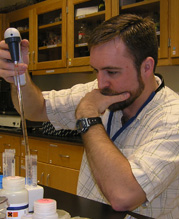Current and Past Student Projects
Travis Odom
Spring 2015
Relationship Analysis of Oligochaetes and related invertebrates using cDNA sequences of the alpha subunit of the Sodium-Potassium ATPase
Abstract
The sodium potassium pump is a ubiquitous membrane protein with important functions in almost every living cell. To name a few, it regulates electrical potentials, cell volume and ion gradients necessary for secondary active transport systems. This ATPase performs an ATP driven anti-transport mechanism, and belongs to the P-class of ATPases. The pumps are composed of two different polypeptides, α and β, and become phosphorylated as part of the transport cycle. The sequence around the phosphorylated residue, located in the larger α subunits, is homologous among different pumps. The purpose of this study is the obtain the cDNA sequences from several Oligochaete invertebrates and compare them with similar sequences from related invertebrates. This information can then be used in the context of molecular evolution of the Annelida.
See Poster |
Current and Past Student Projects
Cristy Guizar and Hannah Zoorob
Fall 2013
Barcoding commercially available Fish specimens for possible misrepresentation and substitution.
Abstract
Recent advantages in species identification via barcoding has resulted in many new revelations, one of which is the mislabeling of seafood products for commercial consumption. Such species mislabeling can be the result of poor visual identification and communication along the supply chain. Of greater concern is the intentional misidentification and representation of seafood products for the sole purpose of defrauding the customers and increasing market profits. Many prepared fish samples are similar in texture and appearance, making it relatively easy to substitute high commercially valued specimens with species of lower value. This project aims to establish an insight if such practices are common in the local area. Specimens will be obtained from larger supply stores, smaller commercial venues and sushi restaurants. DNA will be isolated from the specimen and barcoded using PCR methodology and COX primers. The amplified sequences will be outsourced for sequencing and the resulting data will be compared with available sequences in the National GenBank.
See Poster |
Eunkyu Hahm
Spring 2013
The use of Polymerase Chain Reaction in detecting false specimen advertisement from a Biological Supply Company .
Abstract
Biological Supply Companies often provide live specimens for use in biology classrooms. While most vertebrate species are easily identified, the identification of invertebrates often requires scrutiny. Often, the companies do not provide the taxonimical status of the organism and only provide generic names. In this specific instance, segmented worms were ordered from Ward's Biological Supply mainly because they were advertised as being the common field worm, Alloloborpha calliginosa. Few oligocahetes have been studied with respect the presence of the type Phosphagen kinases (PKs), enzymes that are instrumental in energy metabolism. The aim of this study was to confirm the presence of the LK cDNA in this unstudied oligochaete Alloloborpha calliginosa. These data would provide important information for an ongoing research projects dealing with the molecular evolution of Annelida. The taxonomic identity of the animal was determined via DNA barcoding technology and the cDNA of the putative LK was obtained by means of reverse transcriptase of total isolated RNA and PCR via degenerative primers. Using a BLAST analysis, both the cytochrome oxidase DNA sequence as well as the cDNA sequence for LK indicated that these sequences were 100 % identical to Eisenia fetida, also known as the common redworm or brandling worm. Only an 85 % identity was reported between our COX DNA sequence and the GenBank COX sequence for Alloloborpha calliginosa. This leaves us to conclude that this company did not provide us with the right specimen and/or may be unaware of their lack of control in this part of their supply chain.
Note : The genus Alloloborpha does not exist; Allolobophora caliginosa does exist and is now referred to as Aporrectodea caliginosa
See Poster
|
Casey Wing
Spring 2012
Identification of Oligochaete worms via DNA barcoding.
Abstract
Oligochaetes are freshwater/terrestrial segmented worms that belong to the Phylum Annelida. While the genus of certain worms can be determined quite readily, identification of the specific species is not always straightforward. Case in point, oligochaetes ordered from Biological Supply Companies or from a bait shop often lack complete taxonomic species information. Such identification to the species level was often the job of a specialist in the field. With the availability of increasing amount of molecular data in Gene Banks, the identification of species has become more accessible and sometimes more reliable. The term data mining and DNA barcoding reflect such activities. Barcoding refers to the identification of a short fragment of DNA from which it is possible to extract information needed to classify a specific species. The purpose of this project was to determine the exact taxonomical status of two worms with questionable taxonomic status. One worm, obtained from a local bait shop and lacking scientific description, was suspected to belong to either the genus Lumbricus or Eisenia. The other worm, obtained from a Biological Supply company, was provided with only the genus information (Enchytraeus). The precise information will be important in ongoing research projects dealing with molecular evolution of Annelida.
See Poster |
Ashley Huntsberry
Fall 2010
Identification of Lombricine Kinase in the Oligochaete Enchytraeus through PCR and cDNA analysis.
Abstract
Phosphagen Kinases (PKs) are a family of enzymes that catalyze important metabolic equilibrium reactions in animals, and are important in stabilizing the cellular ATP/ADP ratios during increased energy demands. Whereas vertebrates are characterized by creatine kinase, the invertebrates contain a variety of PKs with the greatest variety seen in the Annelid Phylum. Information on Oligochaetes comes from enzymatic analysis and molecular confirmation is scant. This study aims to provide evidence for the existence of Lombricine Kinase in Enchytraeus, a small terrestrial Oligochaete via cDNA sequence analysis. Additional aims are to identify the introns for this gene in the genomic DNA.
See Poster |
Robert 'Lynn' Graham
Fall 2010
Copper Mortalities in Lumbriculus variegatus: a pilot study to assses proper conditions for examining the expression of catalase
Abstract
The toxicology of heavy metals is associated with the production of free radicals and their reactive cellular destructive effects. The biochemical defense against free radicals is the cellular expression of enzymes that neutralize such free radicals. Catalase is one of such enzymes involved in the neutralization of hydrogen peroxide, resulting from increased superoxide dismutase activity. The purpose of this project was to examine the effect of copper on the expression of catalase in the California Blackworm, Lumbriculus variagatus.
Initial experiments were conducted to determine the maximal copper concentration, which allowed survival of L. variegates such that expression of catalase can be measured over a period of exposure of 3-7 days. Additional goals are to examine the enzymatic levels and gene expression levels (via real time PCR) of catalase in function of temperature and length of exposure.
See Poster |
Ashley Wells
Spring 2010
A search for SuperOxide Dismutases in Leeches and Planarians via PCR and cDNA analysis.
Abstract
The purpose of the project was to search for the presence of the message for SODs in two invertebrate species, Placobdella parasitica (Leech) and Bipalium kuwensi (flatworm). Intitial PCR experiments using degenerative primers for SOD1 were unsuccesful. The use of degenerative primers for SOD2 resulted in positive, clear amplicons. The bands were gel extracted, ligated into pGEM-T Easy vectors and transformed into TOP10 cells. Plasmids were purified from minicultures and the inserts sequenced. Three (3) Leech sequences and four (4) flatworm sequences were quite identical to each other. The translated consensus sequence ( ~ 300 bp) of each was examined via BLAST and each indicated a high homology with mitochondrial MnSOD (SOD2). The next step in this project is to obtain the complete sequence such that a better phylogenetic relationship can be obtained.
Related to this study is an article on page 26 in Allen Image
See Poster |
T.A. Stockton
Summer/Fall 2009
Identification of a SuperOxide Dismutase Enzymes in the California Blackworm through PCR and cDNA analysis.
Abstract
Oxidative stress is characterized by the production of free radicals which can harm cellular structures and processes. Superoxide dismuatses (SODs) are essential enzymes in combating the effects of oxidative stress. The California Blackworm, Lumbriculus variegates, is a freshwater Oligochaete which shows extreme vulnerabilities to pollutants. The purpose of this study is to identify the cDNA structure for SODs. This information can be used to determine if certain pollutants (such as heavy metals) cause up- or down-regulation of the message for this protein and hence provide insights in the cellular mechanisms of dealing with oxidative stress. We present preliminary data on the complete cDNA sequence of Cu/ZnSOD (SOD1) of this Oligochaete species, providing the phylogenetic relationship with other SODs.
This study was presented as a Poster at the Annual Texas Academy of Sciences meeting, March 2010. |
Wendy Gonzales & Stephen Teng
Fall 2008
SEQUENCING OF A MITOCHONDRIAL MANGANESE SUPEROXIDE DISMUTASE (mtMnSOD) cDNA FROM TWO CRUSTACEAN SPECIES.
Abstract
The mitochondrial manganese superoxide dismutase (mtMnSOD) cDNA was cloned from flash-frozen hepatopancreas samples from the red swamp crawfish (Procambarus clarkii) and from claw muscle tissue from the marsh fiddler crab (Uca pugnax). Using degenerative primers, initial cDNA amplicons of 300 and 400 bp were isolated and sequenced respectively.BLAST analysis confirmed these partial sequences to be highly homologous to mtMnSOD from other crustaceans. Phylogenetic analysis groups the sequences together with all known mtMnSODs and in a distinct group from other known SODs.
This study was presented as a Poster at the Annual Texas Academy of Sciences meeting, March 2009.
|
Helen Zhu
Fall 2007 The isolation and phylogenetic comparison of a partial sequence gene encoding the cytosolic manganese superoxide dismutase enzyme in Procambarus clarkii.
Abstract
One of the most abundant free radical byproducts of cellular respiration is superoxide, a highly reactive free radical oxygen variant byproducts with the ability to cause cellular damage. Superoxide Dismutases are essential anti-oxidant enzymes that occur in the cells of all oxygen respiring organisms specifically to catalyze the dismutation of superoxide into less reactive components. Three main types of SODís are currently known, each with distinct functions and classified based on metal content. Manganese SODís are typically found in prokaryotes and the mitochondria of eukaryotes. However, the existence of a distinct cytosolic MnSOD has been shown in a few crustaceans. This project aims to demonstrate and verify the existence of a cytosolic MnSOD in the freshwater crayfish, Procambarus clarkii. A section of the gene encoding the enzyme cytosolic manganese superoxide (cMnSOD) from the freshwater crayfish was isolated, cloned and sequenced. A comparison was made with several known sequences from closely related crustaceans.
This study was presentated at the Annual Texas Academy of Sciences meeting (March 2009) and the full research was published in Zoological Science (2009).
Related to this study is an article in Plano Profile
See Poster |
|
Dr. C. Doumen - 2013
|




